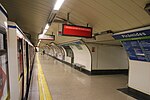Puerta de Toledo
Bien de Interés Cultural landmarks in MadridBuildings and structures in Embajadores neighborhood, MadridCity gates in SpainMonumental gates in MadridNeoclassical architecture in Madrid ... and 1 more
Spanish building and structure stubs

The Puerta de Toledo is a gate located in Madrid, Spain. It was declared Bien de Interés Cultural in 1996. Construction began in 1812, but was not completed until 1827. It was one of the nineteen city gates within the Walls of Philip IV. Puerta de Toledo metro station in on Line 5 of the Madrid Metro.
Excerpt from the Wikipedia article Puerta de Toledo (License: CC BY-SA 3.0, Authors, Images).Puerta de Toledo
Ronda de Segovia, Madrid
Geographical coordinates (GPS) Address External links Nearby Places Show on map
Geographical coordinates (GPS)
| Latitude | Longitude |
|---|---|
| N 40.406721 ° | E -3.711636 ° |
Address
Puerta de Toledo
Ronda de Segovia
28005 Madrid (Centro)
Community of Madrid, Spain
Open on Google Maps










